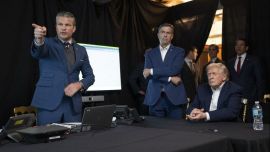At a crucial time, Central Bank chief Miguel Ángel Pesce discusses everything – the need to provide the economy with artificial support, the coronavirus serving as a catalyst for problems the world economy already had, the plans and financial limitations of the State.
Does this crisis turn the world’s central banks into the firemen of the global economy?
[The] Coronavirus [pandemic] has been a catalyst for a series of problems the world economy already had – for example, the abrupt fall in oil prices. While coronavirus was a catalyst, this was not exclusively due to that illness. OPEC and Russia were at odds as to where to fix the price, to which should be added competition with North American shale, the price of which collapsed, as well as the appreciation to which I referred in my previous interview with Perfil – the overvaluation of private financial assets and the slump in stock exchanges around the world. These do not seem to me [to be] only due to coronavirus but to things which catalysed previous situations.
To that may be added the scorn with which this issue was handled in some leading countries, mainly the United States, and the lack of foresight in others such as Italy or Spain. Brazil is the other country handling this issue with disdain – this will end up deepening its recession and crisis.
The countries are responding. There is consensus over two forms of responding – on the one hand, via expansive fiscal policies, and on the other, via the central banks lower ing interest rates. “Quantitative easing,” as printing money is called, has been revived. Central banks are ready to buy assets to grant liquidity to financial markets and give crashing prices a softer landing. The countries which will face up best to this situation are those with the most fiscal room to act, compensating the unemployed and spending in order to face the additional health budgets.
What difference do you see with the 2008-2009 crisis, when you were also in the Central Bank, and in the reactions of the Federal Reserve in the United States?
At that time the Fed responded fundamentally by buying up public assets, both bonds and mortgages, and also other private assets. Now it will aim at buying private assets to sustain prices so that the debacle is not so deep.
What difference do you see between then and now?
The difference is that the Fed already has 20 percent of United States Gross Domestic Product among its assets. This will continue growing, due to the policies they’re going to have to adopt as from now.
In the case of the European Union this percentage is slightly lower but also around 20 percent. That a central bank owns 20 percent of public debt or 20 percent of a country’s GDP shows up very deep flaws in the market. And in that context, the only way to resolve it is action by the central banks and state.
Before the coronavirus crisis broke, this had already emerged as the subject of deep debate in various forums. The idea was that to escape the recessive patterns of the leading countries, the central banks should directly print money to increase public spending. Even before coronavirus, the world was already in a very serious situation.
So the central banks are being asked to solve problems which in many cases exceed them?
Our starting-point is a problem prior to the pandemic. There was already concern over the problem of stagnation in the leading countries except perhaps the US with high growth. BlackRock and some papers voiced this concern – the need for consumer incentives with such bold measures as the central bank directly financing public spending, even without the mediation of the finance ministries.
Trying to explain finance in plain language, could you say that the quarantine is like an extremely extended Sunday and that the shutters will go up again when everything is sorted out, with such costs as wages, rent, electricity bills etc. for all those companies which cannot produce being financed with money printed by the central banks, which will be converted into future debt?
A new component has been added to the recessive situation Argentina already had and for which we were looking for an exit. Luckily it has not affected the price of Argentina’s grain exports, unlike oil which plunged vertically, but will affect our main trading partner for industrial exports, namely Brazil. We were looking for the way out of a recession already lasting three years. In that context one of the components to resolve was the sustainability of Argentina’s debt and that has been aggravated.
Argentina started off with much idle capacity and very high levels of unemployment, which left room for an increment of aggregate demand which did not translate into price increases, especially within the macro-economic conditions established by a government seeking to remove index-linking from wage negotiations, fix utility rates and have a floating exchange rate without lurches in order to avoid inflationary pressures.
Under these conditions and regenerating credit while reducing the stock of bills of exchange with super high interest rates possessed by the banks, the revival of demand was sought. This was interrupted.
This pre-existing circumstance was aggravated by the first effects of the pandemic and the need for this lockdown. What the government is doing is injecting money and credit to sustain demand, so that it does not fall any further, and so that the situation of recession in which we find ourselves is softened by these measures.
We are in a context of emergency, needing to invest in health and many things, to compensate the people who cannot work, especially the least protected sectors of society. This is being done through the effort of the public purse and the mechanism to finance in this context is purely printing money. We hope that the money issued is convalidated by sustaining the production and the credit which it generates, that at the end of the road it finds its way into the hands of companies which sell food or whatever people in quarantine need. Later it may be absorbed by the capital markets for greater investment and development. That would be the virtuous circle which we’re hoping to produce.
In our previous interview I spoke of the importance of developing capital markets and I stand by that. They will generate significant profits which we need to translate into investment.
We could say that in the case of Argentina, the money in circulation in the hands of people is the lowest in history and that perhaps coronavirus generates a desire for more money?
We had a low money supply but also with very low credit in the private sector. When Mercedes Marcó del Pont was running the Central Bank, we aimed for private-sector credit reaching 16 percent of GDP. During the previous government it reached 12 percent and is now around eight percent. We need companies and families to run up debt at reasonable interest rates so that Argentina’s credit market grows.
Does the coronavirus crisis kill your idea that single-digit inflation can be reached in a more or less short term, as you said in the last interview in the last quarter of 2019?
We are in the key scenario of a critical moment. We have to see how the economy digests this expansion of credit and money we are generating without major inflationary pressures. But I must recognise that I’m now losing my optimism as to the intention of lowering inflation quickly.
Is there a risk of the measures stoking inflation?
There shouldn’t be. Government policies are prudent with regard to utility billing. The exchange rate is geared so as not to generate shocks or lurches which accelerate inflation. To that should be added the idle capacity and high unemployment. There are no structural reasons for inflationary pressures. Inflationary momentum and the disorder provoked by the pandemic make the context difficult. That’s why I’m losing my optimism as to the possibility of lowering inflation.
Santa Fe Governor Omar Perotti has spoken of the possibility of his province recurring to quasi-currencies because it is unable to meet its obligations. Would this justify the Treasury extending its federal revenue-sharing with the provinces and municipalities to the pesos it is issuing or the Central Bank making transfers to compensate partially the shrinkage in provincial revenues and avoid that alternative?
The national government w ill cooperate with the provinces to hold up salaries. We have been talking about the need to sustain consumption from the social as much as the economic point of view. It would be best to generate credit via expanding the money supply of the national currency and not revive these homemade credit systems from the previous crisis. The government will collaborate with the provinces in this sense.
Does the coronavirus permit us the opportunity, and even oblige us, to think of a shock heterodox plan, not gradualism, to lower inflation more drastically and at the same time revive the economy? Could the crisis be the midwife of the need for different forms of economic intervention than those planned?
It is impossible for the public sector to compensate, via spending, the fall in economic activity which we are going to suffer due to the lockdown. That is absolutely impossible. It can soften the blow and avoid the least-protected sectors of society not having enough money to make it through this period of quarantine. But no way can it be thought that the state can completely compensate for the fall in production which we are going to suffer. But the virtuous circle would be that the generation of credit via printing money would be afterwards absorbed by the capital markets and can be used again for growth.
I recently interviewed Manuel Trajtenberg, architect of the Israeli economic miracle, when the starting-point was 500 percent monthly inflation in the 1980s, different from 20 to 40 percent annual inflation, which would not justify a heterodox shock plan. But the world economic crisis on the way approaches 1929 levels, with talk of a 15 percent fall in the world’s gross product in the second quarter, while Argentina is now undergoing the worst GDP fall in its history. Wouldn’t such extraordinary conditions make one think that it could be necessary to have a heterodox plan which tries at the same time to attack a possible increase in inflation and the fall of activity?
Before the coronavirus crisis we had a heterodox plan. The Central Bank was financing the primary deficit, fundamentally in an effort to sustain public investment. Generally in the first quarters of the year, especially when there is a change of government, public investment does not have the impulse it later acquires in subsequent quarters. We will go ahead with this without a doubt. To grow we need the risk of a pandemic to fade and everybody to go back to work. There is no way we can compensate for this. Once credit has been generated, as is happening now with the expansion of the money supply, and when the productive machinery is functioning again, the available credit can be a motor for investment and growth.
You have explained that the rumours [in the local media] which have you confronting various sectors of t he government’s economic team do not correspond to reality. But I suppose that within any group there has to be a certain degree of dissent and exchange of ideas. Are there different views on how to tackle coronavirus within the government? Firstly, I deny the rumours. There are many kinds of journalism but the journalism which invents things is harmful.They spoke of meetings which did not exist, mentioning emergency decrees, a reform of the Central Bank statutes and a whole bunch of things which never existed.
You read articles which have me yelling at other members of the government over our positions. Undoubtedly we have different viewpoints on many things but fortunately these different viewpoints can be resolved internally without leaking out. We achieved consensus long before it could become a problem and especially as from the crisis provoked by the pandemic, even more so now. We might differ in focus but we are all moving in the same direction, mutually supporting each other and seeking solutions by consensus.
Could it be said that you continue to interpret fiscal caution as necessary, despite the deepened crisis, and that Production Ministro Matías Kulfas pursues a more Keynesian line?
No way. There is consensus that the spending we are carrying forward is what the crisis requires. We have no differences there.
Do you agree with lowering pay in both the public and private sectors?
That is an issue on which we have to work. The Labour Ministry will be working on it when it sees the extent of the crisis. It has not been necessary until now and a series of instruments already in existence is being deployed to attend to companies via the crisis programmes which the Labour Ministry runs with assistance from the Treasury, something we are also trying out so that small and medium-sized companies have access to the credit to pay wages.
What message would you like to leave this audience with regard to your vision of how to emerge from this coronavirus crisis?
In this context you have to privilege public health and listen to the professionals who understand these issues. According to those opinions, we can then see what sectors and within what time frames can go to lifting the lockdown, so that the inactive can go back to work.
The health issue is fundamental. What we are seeing in other countries is straight out of Dante’s Inferno. It is incredible that they cannot gather their dead, that there are countries which are equipping refrigerated containers in order to be able to stock the corpses. It makes your flesh crawl.
We only come out of this with consensus and with society and each one of us behaving themselves. In the measure of possibilities, economic activities will be liberated so that they can produce again.
My second message, which is not so general, is for the financial sector and capital markets – that we have to go on working to be able to absorb Argentina’s saving capacity and the credit we are generating during this crisis in order to be able to sustain the levels of consumption and activity.
Do you imagine that in the specific case of Argentina that recovery will take the form of a “V” or a “U”? Will there be a rapid rebound?
It will take time, it does not seem to me that we have room for optimism. We are going to have to face falls in production and critical situations provoked by coronavirus according to the strategies chosen by each country – whether it privileges maintaining the levels of activity or preventing higher levels of contagion and death, in both cases the levels of production will be extremely affected.
After the economy we will then have to face those underlying situations which were already there such as overvalued assets and all the rest of it. That will be another question to be absorbed by the productive apparatus and the savings systems, which will affect the pension systems of the leading countries.
We cannot be optimistic as to the global economy’s possibilities of recovery. We have to try to grow via domestic investment and consumption and for that we’re going to need all the foreign currency available. Each dollar we can destine to imports means growth.


























Comments